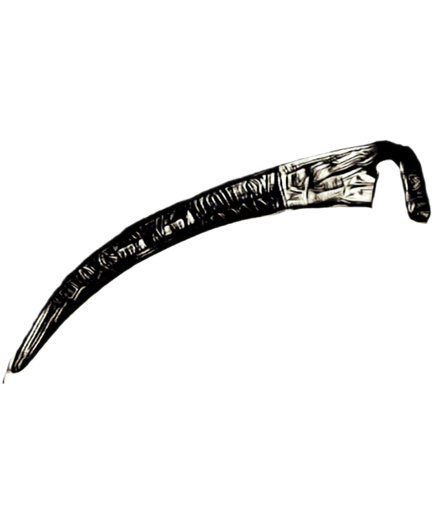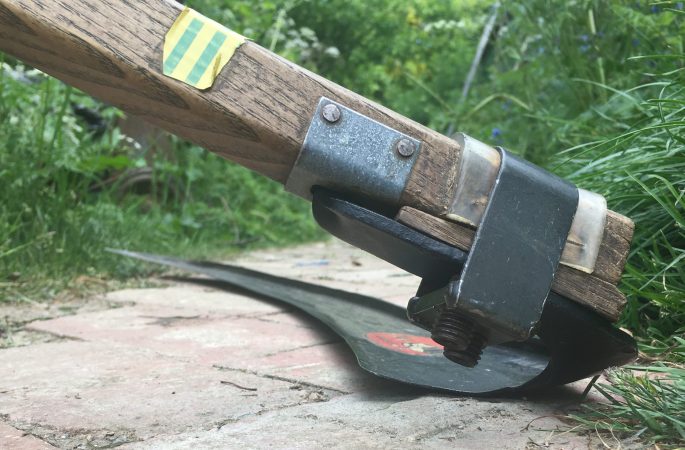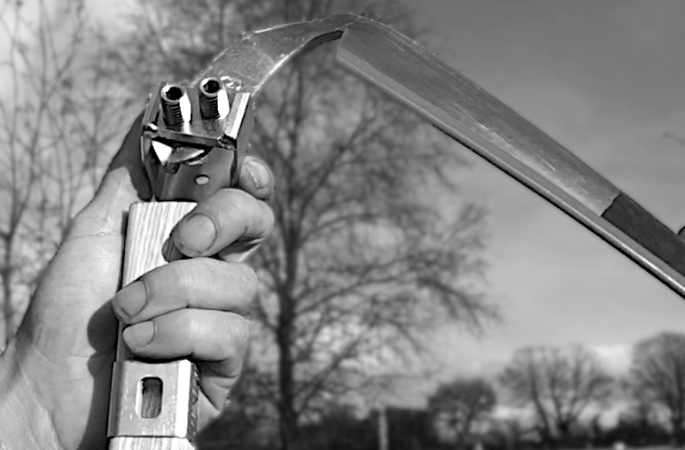
To mow well, the scythe blade needs to be set correctly.
There are three words used to describe the relationship of a scythe blade to the snath and to the ground – the hafting angle, the lay and the neigung angle. The first two of these can easily be adjusted by the scyther to influence how the blade mows.
- The lay describes how far the edge of the blade is from the ground.
- The hafting angle describes the angle the blade makes to the snath, when viewed from above.
- The neigung or tilt of the blade describes the lift of the point of the blade in relation to the body of the blade.

Hafting Angle – The Fundamentals
The hafting angle describes the angle the blade makes with the snath, when seen from above.

Hafting Angle Range
Scythe blades can be set at a range of hafting angles.
The possible range for any one blade is dictated by the angle the blade tang is set at, relative to the body of the blade, by the manufacturer.
The hafting angle can be fine-tuned by the scyther by altering the position of the tang in the clamp (before the grub screws are fully tightened).

If you blade is well matched to your snath, the blade should have sufficient range in the hafting angle to enable you to set it to suit your mowing style and conditions.
Hafting angles are described as “closed” or “open”.
A closed hafting angle
The blade is set so there is a smaller angle between the blade and the snath.. The tang is closer to the side of the clamp nearest the blade (commonly called the front of the clamp)
An open hafting angle
The blade is set so there is a larger angle between the blade and the snath. The tang is closer to the side of the clamp furthest from the blade (commonly called the back of the clamp)

When mowing, the blade needs to meet the vegetation with a slicing action to cut effectively.
The hafting angle will influence:
- the angle at which the blade edge meets the vegetation. Closed angles give a slicing action. As the hafting angle opens out, a chopping action becomes more noticeable.
- how deeply the blade cuts into the sward. The more open the angle, the more the blade will attempt to cut with each pass.
The ideal hafting angle
With a well set hafting angle, the blade will cut with a nice slicing action. It will take a reasonable bite of vegetation with each pass of the scythe without getting stuck.
The video below shows Phil mowing a lawn with a slicing, sweeping stroke. Scything short grass demonstrates the path the scythe takes very well.
Scythers should aim to use the same pattern of stroke in longer vegetation too, or parts of the stroke if trimming vegetation.
If the hafting angle is very closed the blade will have a lot of slicing action but will not bite very deeply into the sward.
It will mow with a slicing action more easily.
- Beginners may find it easier to learn to mow with a slightly more closed hafting angle as it can help correct some early errors in technique.
The blade will shave off a small depth of vegetation with each pass of the scythe.
- This makes scything slower.
- Beginners may find they move the scythe on too far between strokes.
- This can leave a fringe of uncut vegetation between scythe passes, or even mean the blade gets stuck if it ends up too deeply into the uncut sward and gets caught up in vegetation it can’t cut.
If the hafting angle is very open the blade will have more chopping angle and will bite deeply into the sward with each pass.
It will mow with a chopping action more easily.
- It is harder to complete a “slice” across the whole width of the stroke.
- This encourages mowers to use a chopping action, repeatedly swinging at the sward to complete a pass, rather then cutting it all in one slice.
The blade will attempt to cut a greater depth of vegetation with each pass of the scythe.
- If the scythe is cutting too deeply into the sward, the scyther won’t be able to complete a smooth stroke across.
- The scythe gets stuck on the uncut grass, which exacerbates the temptation to repeatedly chop at the grass as described above.
The risks of a very open hafting angle
As the blade is not cutting very well, the scyther can be tempted to lift up the scythe at the beginning of the stroke to chop it into the grass with more force.
This can lead to a “golf swing” style of mowing, where the scythe is lifted up high and swung down into the sward. The blade is then swung up again at the end of the stroke
This style of mowing is inefficient, as the scythe is only cutting vegetation in the middle of the stroke, when it near the ground.
There is a high risk of damaging your clamp, blade or snath if you mow like this.
- Chopping into the grass with more force means that, should you hit an obstacle, there is more energy to be dissipated that can lead to breakages.
- The chopping action increase the chance you will drive the point of the blade into the ground, with similar consequences.
An early symptom is damage or misshaping of the back of the clamp as the tang of the blade is forced back against it. More seriously, there can be damage to the blade or snath, which are much more expensive to replace.

Setting the Hafting Angle
NOTE we will add a full hafting video soon.
1) Place the upper grip of the scythe on your right knee, with the scythe pointing straight in front of you.
- This will act as a static fulcrum point as you rotate the scythe
2) Mark the position where the beard of the blade lies on the ground.
- Use an allen key or similar. Or a handy leaf!

3) Using your knee as a pivot point rotate the scythe clockwise, until the tip of the blade is in line with where the beard was.
- It will probably not lie on the exact same spot, but will be a few cm’s closer to you.

The difference between the start position of the beard of the blade and the end position of the tip of the blade is a measure of the hafting angle.
As a rule, the tip of the blade should fall 3-5cm inside of the beard, depending on blade being used.
To adjust the hafting angle, slightly loosen the grub screws and move the tang in the clamp.
- Make small adjustments, based on the measurement you made in the previous stage.
- To open (increase) the hafting angle, move the tang towards the back of the clamp.
- To close (decrease) the hafting angle, move the tang towards the front of the clamp.
Tighten the grub screws enough that the blade won’t move and check your hafting angle again.
Once the hafting angle is correctly set, fully tighten the grub screws, using the long arm of the Allen key for extra leverage, so the blade will not move in use.
NOTE – TO PROTECT YOUR SCYTHE FROM DAMAGE
It is very important that you check the hafting angle is correctly set and the grub screws are tight BEFORE EVERY USE.
A loose blade or a very open hafting angle (especially in combination with a blunt blade and forceful mowing) puts excess stress on the clamp, blade and snath and can lead to damage or breakages
See “THE RISKS OF A VERY OPEN HAFTING ANGLE”, above.
As a general rule, the tip of the blade should fall 3-5cm inside of the beard.
When hafting shorter blades you generally need the lower end of the range.
When hafting longer blades, you generally need the higher end of the range.
Hafting angle is somewhat subjective. The setting you need depends on your individual mowing style, the style and length of blade you are using and the vegetation you are cutting.
The best way to learn what works for you is to experiment.
When a more closed angle is useful.
If you are mowing rough vegetation eg bracken, brambles it can be useful to set your blade slightly more closed to protect the clamp, blade and snath from damage.
More Information


